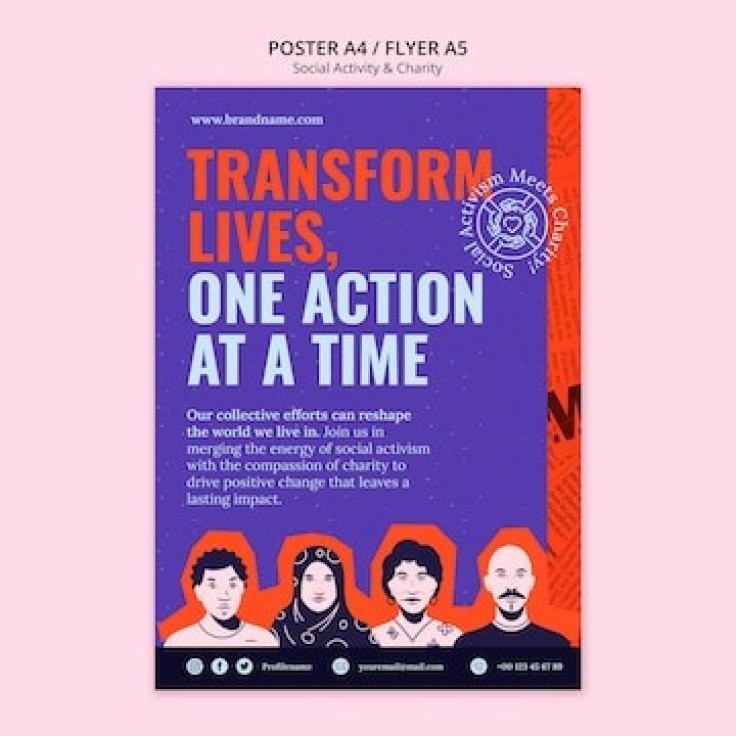Unleashing the Power of Data Visualization: Transforming Social Impact Initiatives
Created by
Data has become a valuable asset in driving social impact initiatives in today's digital age. However, more than raw data is needed to create meaningful change. This is where data visualization comes into play. Data visualization is the art of presenting complex information visually, making it easier to understand and analyze. Organizations can effectively communicate their findings, engage stakeholders, and drive action by transforming data into visual representations such as charts, graphs, and maps.
The Importance of Data Visualization in Social Impact Initiatives
Data visualization plays a crucial role in social impact initiatives for several reasons.
• Streamlining: Data visualization helps to simplify complex data sets, making them accessible to a broader audience. Presenting information visually lets even individuals without a background in data analysis quickly understand critical insights and trends. This enables organizations to engage diverse stakeholders, including policymakers, donors, and the general public.
• Accountability and Transparency: Organizations can demonstrate the impact of their initiatives and hold themselves accountable for their goal using data visualization. This helps build stakeholders' trust and ensures that resources are allocated effectively.
• Data-driven decision-making: Organizations can also identify patterns, correlations, and outliers that may not be apparent in raw data using different visualization techniques. This enables them to make informed decisions and take action based on evidence. For example, a nonprofit organization working to combat climate change can use visualizations to identify regions with the highest carbon emissions and target their efforts accordingly.
Real-Life Examples of Data Visualization for Social Impact
Data visualization has been widely adopted in various social impact initiatives, leading to tangible results. We will look at some of the data visualization initiatives and work done in this area.
1. Using Data Visualization to Track and Combat Climate Change
Climate change is one of the most pressing challenges of our time, and data visualization plays a crucial role in understanding its impact and driving action. Visualizing climate data lets organizations effectively communicate the situation's urgency and engage stakeholders in climate action.
One such data visualization is the use of interactive climate change dashboards. These dashboards provide real-time data on critical indicators such as temperature rise, carbon emissions, and deforestation. They allow users to explore trends, compare data across regions, and understand the correlation of various factors contributing to climate change. If organizations visualize this data, they can raise awareness, inform policy decisions, and mobilize communities to take action.
The climate explorer dashboard developed by the National Oceanic and Atmospheric Administration (NOAA) allows users to explore climate projections for different scenarios, such as business-as-usual or aggressive emissions reductions. This visualization tool helps policymakers and community leaders understand the potential impacts of climate change on their regions and develop strategies to mitigate and adapt to these changes.
2. Data Visualization for Promoting Gender Equality
Gender equality is a fundamental human right. Data visualization can play a decisive role in promoting this agenda. Visualizing gender-related data allows organizations to highlight the disparities between men and women, challenge gender stereotypes, and advocate for policy interventions.
One practical approach is using interactive study that presents data on key gender indicators such as education, employment, and political representation. These studies allow users to explore data at different levels of granularity, from global trends to country-specific statistics. By visualizing these disparities, organizations can raise awareness, inspire public discourse, and drive policy change.
Similarly, the Gender Data Portal developed by the World Bank provides an interactive visualization of gender indicators worldwide. Users can explore data on topics such as labor force participation, gender wage gaps, and access to education. This visualization tool helps policymakers and researchers identify areas where gender disparities are most pronounced and develop targeted interventions to address these challenges.
3. Data Visualization in Addressing the COVID-19 Pandemic
The COVID-19 pandemic has highlighted the importance of data visualization in understanding and responding to public health crises. Visualizing real-time data on infection rates, hospital capacity, and vaccination progress allows organizations and governments to effectively communicate the impact of the virus and inform public health measures.
One prominent example is the use of COVID-19 dashboards. These dashboards provide up-to-date information on the number of cases, deaths, recoveries, and other relevant data such as testing capacity and vaccination rates. When organizations visualize this data at different geographic levels, from global to local, they can help individuals make informed decisions about their health and safety.
The COVID-19 dashboard developed by Johns Hopkins University is a prime example of effective data visualization in the context of the pandemic. This interactive dashboard provides real-time data on the spread of the virus, allowing users to track the number of cases, deaths, and recoveries worldwide. Through data visualization, the dashboard helps policymakers, healthcare professionals, and the general public understand the scale of the pandemic and take appropriate action.
Tools and Techniques for Effective Data Visualization
Organizations can leverage various tools and techniques to create impactful data visualizations. Here are some key considerations:
• Different data types lend themselves to different visualizations. Bar charts are ideal for comparing values, line charts showing trends over time, and maps for visualizing geographic data. Organizations can effectively convey their message and engage their audience by choosing the proper format.
• Data visualizations should be clear and easy to understand. Avoid cluttering the visualization with unnecessary elements and focus on the key insights. Use color and labels wisely to avoid overwhelming the viewer.
• Data visualizations should not merely represent numbers. They should tell a compelling story and convey a message. Consider the narrative you want to share and design the visualization accordingly.
• Creating impactful data visualizations is an iterative process. Test your visualizations with different audiences and gather feedback. Refine your designs based on the insights gained and continue to iterate until you achieve the desired impact.
Best Practices for Creating Impactful Data Visualizations
To create impactful data visualizations for social impact initiatives, organizations should follow these best practices:
• Know your audience: Understand the needs and preferences of your target audience. Tailor your visualizations to their level of expertise and familiarity with data.
• Use color strategically: Color can enhance the visual appeal of visualization, but it should also serve a purpose. Use color to highlight key insights or differentiate between categories.
• Provide context: Contextualize your data by providing relevant background information and explaining the significance of the findings. Help your audience understand the broader implications of the data.
• Ensure accessibility: Consider the needs of individuals with visual impairments or other disabilities. Use alt text for images, provide text descriptions of visualizations, and choose color palettes accessible to colorblind individuals.
• Please keep it simple: Avoid unnecessary complexity and focus on the key insights. Use clear and concise labels, avoid jargon, and present data in a straightforward manner.
Challenges and Limitations of Data Visualization for Social Impact
While data visualization is a powerful tool for driving social impact, it has challenges and limitations. Here are a few to consider:
• Data quality and availability: Data visualizations are only as good as the data they are based on. Data quality or adequate data availability can limit the effectiveness of visualizations and compromise the insights they provide.
• Data privacy and security: Organizations must ensure that the data used for visualization is handled securely and complies with privacy regulations. This can be particularly challenging when working with sensitive data, such as health records or personal information.
• Interpretation and bias: Data visualizations can be subject to interpretation and may inadvertently introduce biases. It is essential to be transparent about the limitations of the data and avoid making unwarranted conclusions based on visualizations alone.
• Technical skills and resources: Creating compelling data visualizations requires technical skills and resources. Organizations may need to invest in specialized software, hire data visualization experts, or train their staff in data analysis and visualization techniques.
• Accessibility and inclusivity: Not all individuals have equal access to technology or the ability to interpret visualizations. Organizations should consider alternative formats like text-based summaries or audio descriptions to ensure inclusivity.
Harnessing the Power of Data Visualization for a Better Future
Data visualization is powerful for driving social impact and promoting positive change. Organizations can engage stakeholders, inform decision-making, and advocate for policy change by transforming complex data into visual representations. From tracking and combating climate change to promoting gender equality and addressing the COVID-19 pandemic, data visualization can transform social impact initiatives and create a better future for all.
As we continue to harness the power of data visualization, it is crucial to be mindful of the challenges and limitations that come with it. If we address these challenges and embrace best practices, we can maximize the impact of data visualization and drive meaningful change.
© 2025 University Herald, All rights reserved. Do not reproduce without permission.








